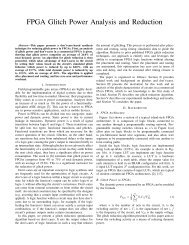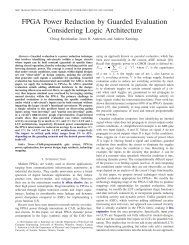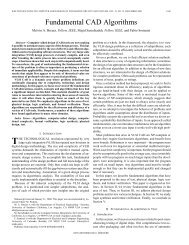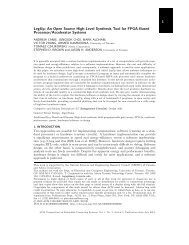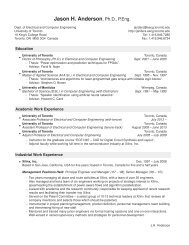Power Optimization and Prediction Techniques for FPGAs - Jason H ...
Power Optimization and Prediction Techniques for FPGAs - Jason H ...
Power Optimization and Prediction Techniques for FPGAs - Jason H ...
You also want an ePaper? Increase the reach of your titles
YUMPU automatically turns print PDFs into web optimized ePapers that Google loves.
1.2 MotivationDespite the relative weakness of <strong>FPGAs</strong> from the power angle, their power consumption has,until recently, been largely ignored by the research community. Likewise, no commercial FPGAvendors offer hardware or software specifically targeted to low-power applications. The extentto which FPGA power can be optimized through either CAD, architecture, or circuit techniqueshas been an open question. The focus of commercial vendors, as well as the majority ofpublished research on FPGA architecture <strong>and</strong> CAD, has concentrated on improving FPGA areaefficiency<strong>and</strong> per<strong>for</strong>mance. A thorough treatment of prior research on FPGA speed <strong>and</strong> areais outside the scope here; however, references [Rose 89, Rose 91, Betz 96, Betz 97a, Betz 99a]present the first <strong>and</strong> seminal work on FPGA logic <strong>and</strong> routing architecture, with importantfollow-up work appearing in [Sing 90, Marq 99, Ahme 02]. CAD algorithms that optimize thearea <strong>and</strong> per<strong>for</strong>mance of <strong>FPGAs</strong> are well-studied, with some of the most important papers being[Brow 90, Fran 90, Fran 91a, Lemi 93, Cong 94a, Cong 94b, McMu 95, Betz 97b]. Thougharea <strong>and</strong> speed have been the main research focus to date, power is likely to be a key considerationin the design of future <strong>FPGAs</strong>, <strong>for</strong> the reasons outlined below.A well-known consequence of technology scaling is the rapid increase in static (leakage)power relative to dynamic power. Dynamic power is consumed as a result of logic transitionsthat occur on a circuit’s signals during normal operation. It increases in proportion to therate of logic transitions (switching activity) on circuit signals <strong>and</strong> the amount of capacitancecharged <strong>and</strong> discharged during logic transitions. Leakage power is consumed when a circuit is ina quiescent, idle state. Both dynamic <strong>and</strong> leakage power consumption have become major issues<strong>for</strong> semiconductor vendors <strong>and</strong> their customers [Inte 02]. Moreover, the considerable increase inleakage with each process generation has significant implications <strong>for</strong> <strong>FPGAs</strong>. Leakage currentin a circuit is proportional to the circuit’s total drawn transistor width [Jian 02]. Since <strong>FPGAs</strong>contain a huge number of transistors, as required to provide programmability, the need <strong>for</strong>effective leakage management techniques is amplified in <strong>FPGAs</strong> versus in other technologies.Given this, low leakage is certain to be a significant design objective in next-generation <strong>FPGAs</strong>.Optimizing the power consumption of <strong>FPGAs</strong> has a number of benefits.First, reduced3



